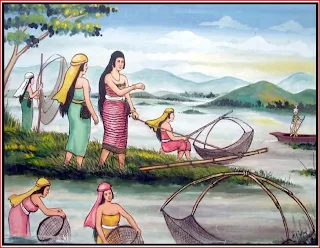Under the guidance of four traditional painters of the Royal Guild (Karigar Loishang), eight young contemporary artists took part in a workshop jointly organized by IGRMS and Manipur State Museum in the year 2000 at Imphal.
These paintings depict some of the interesting episode of the legendary epic of Moirang Kingdom - the Khamba and Thoibi. The myth of Moirang is unveiled from the tragic end of an adoring pair of he-pegion and she-pegion. An unknown hunter in his own delight had killed the birds. This unfaithful incident had alienated the union of the two souls in this living world. It was under the willful act of the Almighty that the two souls took rebirth successively up to their ninth humanly reincarnations. The seventh rebirth has stamped a spectacular event of prowess, treachery and conflict of human sentiment into this Kingdom. Khamba- the poor orphan born in a poor family and his only sister Khamnu gave all her utmost care to grow a faithful brother who always strives for the truth. This handsome and brave youth of Moirang fall in love with Thoibi- the princess of Moirang. The ultimate union of their love came after a long struggle. On this faithful day of their destiny a tragic end suddenly appeared when Khamba joked to test the faithfulness of his lover by changing his voice as another youth of Moirang. As a result of this act he was unknowingly speared by his sweet heart from inside a dark room of the house. The “Seventh Rebirth” in every hit of the land is passed down from generation to generation by the minstrel traditions of the Pena singers, dance, plays and acts.
Painting No.1
Thoibina Matasinga in chingba
Princess Thoibi fishing with her maids
Painting No. 2
Thoibina Phi Saringeida Khambana Koirakpa
Khamba visiting to meet Thoibi when weaving
Painting No.3
Lei Langba
Offering of flowers
to continue.....



Comments
Keep it up. best wishes,
Anyway, just wanted to say wonderful blog!
Here is my homepage; relaxsessel